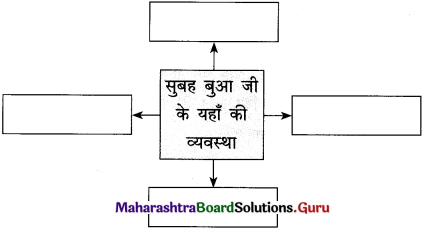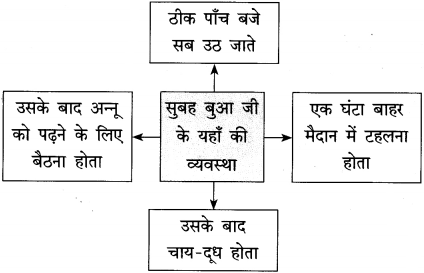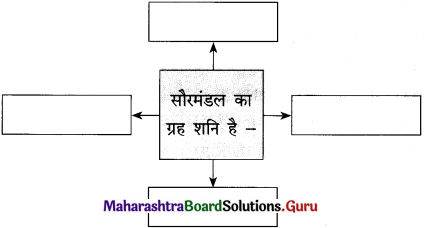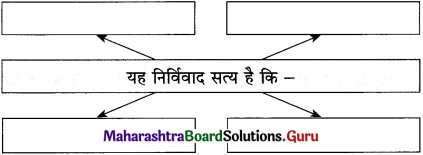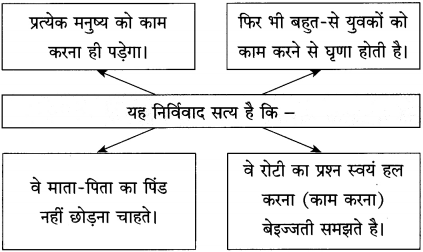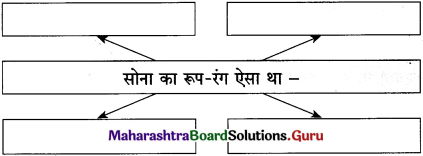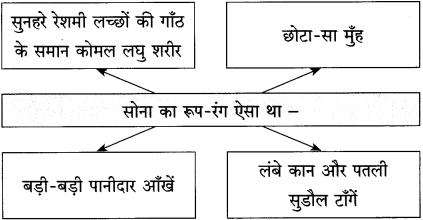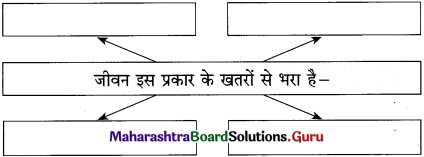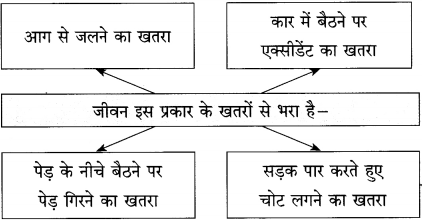Balbharti Maharashtra State Board Hindi Yuvakbharati 12th Digest व्याकरण Notes, Questions and Answers.
Maharashtra State Board 12th Hindi परिशिष मुहावरे
Maharashtra Board Class 12 Hindi व्याकरण अलंकार
का साधारण अर्थ आभूषण होता है। जिस प्रकार आभूषणों से शरीर की सुंदरता में वृद्धि होती है, उसी प्रकार जिन उपकरणों से काव्य में सौंदर्य उत्पन्न होता है, उन्हें अलंकार कहते हैं। अलंकार काव्य में शब्दों एवं अर्थों की सुंदरता में वृद्धि करके चमत्कार पैदा करते हैं। इनके कारण काव्य की भाषा में निखार उत्पन्न होता है।
साहित्य में शब्द और अर्थ दोनों का महत्त्व होता है। इस आधार पर अलंकार के मुख्य रूप से तीन भेद माने जाते हैं :
- शब्दालंकार
- अर्थालंकार
- उभयालंकार।
कक्षा ग्यारहवीं में हमने शब्दालंकार का अध्ययन किया था। यहाँ हम अर्थालंकार का अध्ययन करेंगे।
अर्थालंकार : जहाँ शब्दों के अर्थ से चमत्कार स्पष्ट होता है, वहाँ अर्थालंकार माना जाता है।
अर्थालंकार के भेद :
अर्थालंकार के पाँच प्रकार होते हैं :
- रूपक अलंकार
- उपमा अलंकार
- उत्प्रेक्षा अलंकार
- अतिशयोक्ति अलंकार
- दृष्टांत अलंकार।
1) रूपक अलंकार : जहाँ उपमेय पर उपमान का आरोप होता है, वहाँ रूपक अलंकार होता है। आरोप का अर्थ है, एक वस्तु के साथ दूसरी वस्तु को इस प्रकार रखा जाए कि दोनों अभिन्न मालूम हों। अर्थात् दोनों एकरूप मालूम हों। इस अलंकार में उपमेय और उपमान को एकरूप बना दिया जाता है।
जैसे –
चरण कमल बंदौं हरिराई।
यहाँ भगवान के चरणों (उपमेय) में कमल (उपमान) का आरोप हुआ है।
अथवा
उदित उदय गिरि मंच पर
रघुबर बाल पतंग।
प्रस्तुत दोहे में ‘उदय गिरि’ का ‘मंच’ पर तथा ‘बाल पतंग’ का ‘रघुबर’ पर आरोप किया गया है।
अतः यहाँ रूपक अलंकार है।
(2) उपमा अलंकार : उपमा का अर्थ है समता अथवा तुलना।
जहाँ स्वभाव, गुण, धर्म, रूप, रंग अथवा आकार आदि की समानता के आधार पर एक वस्तु की दूसरी प्रसिद्ध वस्तु के साथ तुलना है की जाती है, अर्थात् जहाँ उपमेय की तुलना उपमान से की जाती है, वहाँ उपमा अलंकार उत्पन्न होता है। जैसे –
- पीपर पात सरिस मन डोला।
- चरण-कमल-सम कोमल।
- राधा वदन चंद सो सुंदर।
यहाँ मन की तुलना पीपर के पात से, चरण की तुलना कोमल कमल से तथा राधा के वदन की तुलना चंद्रमा से की गई है। इसलिए यहाँ उपमा अलंकार है।
(3) उत्प्रेक्षा अलंकार : उत्प्रेक्षा का अर्थ है – उत् + प्र + ईच्छा। अर्थात् प्रकट रूप से देखना। यहाँ देखने का अर्थ है संभावना करना।
जहाँ पर उपमेय में उपमान की संभावना प्रकट की जाए या उपमेय को ही उपमान मान लिया जाए, वहाँ उत्प्रेक्षा अलंकार होता है।
इस अलंकार में मानो, जानो, जनु-जानहुँ, मनु-मानहुँ, इव जैसे शब्दों का प्रयोग किया जाता है। जैसे –
(1) कहती हुई यों उत्तरा के नेत्र जल से भर गए।
हिम के कणों से पूर्ण मानो हो गए पंकज नए।
इन पंक्तियों में उत्तरा के अश्रुपूर्ण नेत्रों (उपमेय) में ओस जलकण युक्त पंकज (उपमान) की संभावना की गई है।
(2) सोहत ओढ़े पीत पट, श्याम सलोने गात। है
मनो नीलमणि शैल पर, आतप पर्यो प्रभात।।
इस दोहे में उपमेय पीताम्बर ओढ़े हुए श्याम वर्ण के श्रीकृष्ण हैं और उपमान नीलमणि के पर्वत पर पड़ने वाली प्रातःकालीन धूप है। ‘मनो’ शब्द का प्रयोग कर उपमान की उपमेय में संभावना व्यक्त की गई है।
(3) सखि सोहत गोपाल के, उर गुंजन की माल।
बहार लसत मनो पिए, दावानल की ज्वाल।।
यहाँ गुंजा की माला (उपमेय) में दावानल की ज्वाला (उपमान) की संभावना होने से उत्प्रेक्षा अलंकार है।
(4) अतिशयोक्ति अलंकार : जहाँ किसी वस्तु का वर्णन इतना बढ़ा-चढ़ाकर किया जाए कि वह लोक सीमा को पार कर जाए, है वहाँ अतिशयोक्ति अलंकार होता है। जैसे –
(1) जेहि बर बाजि राम असवारा।
तेहि सारद हुँ न बरनै पारा॥
यहाँ यह कह गया है कि जिस उत्तम घोड़े पर श्रीराम सवार हैं, उसका वर्णन सरस्वती जी भी नहीं कर सकतीं। यह बात बहुत बढ़ा-चढ़ाकर कही गई है। इसलिए यहाँ अतिशयोक्ति अलंकार है।
(2) हनूमान की पूँछ में, लग न पाई आग।
लंका सारी जल गई, गए निशाचर भाग।।
यहाँ भी बात को बहुत बढ़ा-चढ़ाकर कहा गया है। अतः यहाँ भी अतिशयोक्ति अलंकार है।
(3) वह शर इधर गांडीव गुण से, भिन्न जैसे ही हुआ।
धड़ से जयद्रथ का इधर सिर, छिन्न वैसे ही हुआ।
इन पंक्तियों में कहा गया है कि गांडीव धनुष से बाण जैसे ही छूटा, तभी जयद्रथ का सिर धड़ से अलग हो गया। यहाँ भी बात को बढ़ा-चढ़ाकर कहा गया है।
(5) दृष्टांत अलंकार : दृष्टांत का अर्थ है उदाहरण। जब किसी बात की सत्यता को प्रमाणित करने के लिए उसी प्रकार की कोई दूसरी बात कही जाती है, जिससे पूर्व कथन की प्रामाणिकता सिद्ध हो जाए, तो वहाँ दृष्टांत अलंकार होता है। दृष्टांत में दो स्वतंत्र वाक्य रहते हैं। दोनों के अर्थ एक जैसे होते हैं। जैसे –
करत-करत अभ्यास के, जड़ मति होत सुजान।
रसरी आवत जात से, सिल पर परत निसान॥
यहाँ अभ्यास करते-करते निर्बुद्धि व्यक्ति का प्रवीण होना वैसा ही है, जैसे रस्सी के आने-जाने से सिल (पत्थर की पटिया) पर निशान पड़ना। यहाँ पहले वाक्य की सच्चाई सिद्ध करने के लिए दृष्टांत रूप में दूसरा वाक्य आया है। इस प्रकार यहाँ दृष्टांत अलंकार है।
कृति-स्वाध्याय एवं उत्तर
प्रश्न. निम्नलिखित पंक्तियों में उद्धृत अलंकार पहचानकर उसका नाम लिखिए :
प्रश्न 1.
पायोजी मैंने राम रतन धन पायो।
उत्तर :
रूपक अलंकार।
प्रश्न 2.
सोहत ओढ़े पीत पट, श्याम सलोने गात।
मनो नीलमनि शैल पर, आतप पर्यो प्रभात।।
उत्तर :
उत्प्रेक्षा अलंकार।
प्रश्न 3.
सबै सहायक सबल के, कोउ न निबल सहाय।
पवन जगावत आग ही, दीपहिं देत बुझाय।।
उत्तर :
दृष्टांत अलंकार।
प्रश्न 4.
पड़ी अचानक नदी अपार
घोड़ा उतरे कैसे पार।।
राणा ने सोचा इस पार।
तब तक चेतक था उस पार।।
उत्तर :
अतिशयोक्ति अलंकार।
प्रश्न 5.
जियु बिनु देह, नदी बिनु वारी।
तैसे हि अनाथ, पुरुष बिनु नारी।।
उत्तर :
उपमा अलंकार।
प्रश्न 6.
झूठे जानि न संग्रही, मन मुँह निकसै बैन।
याहि ते मानहुँ किए, बातनु को बिधि नैन।।
उत्तर :
उत्प्रेक्षा अलंकार।
प्रश्न 7.
राधा-वदन चंद सो सुंदर।
उत्तर :
उपमा अलंकार।
प्रश्न 8.
चरण-सरोज पखारन लागा।
उत्तर :
रूपक अलंकार।
प्रश्न 9.
मोती की लड़ियों से सुंदर, झरते हैं झाग भरे निर्झर।
उत्तर :
उपमा अलंकार।
प्रश्न 10.
उस क्रोध के मारे, तनु उसका काँपने लगा।
मानो हवा के जोर से, सोता हुआ सागर जगा।।
उत्तर :
उत्प्रेक्षा अलंकार।
प्रश्न. निम्नलिखित अलंकारों से युक्त पंक्तियाँ लिखिए :
प्रश्न 1.
उपमा अलंकार :
उत्तर :
ऊँची-नीची सड़क, बुढ़िया के कूबड़-सी।
नंदनवन-सी फूल उठी, छोटी सी कुटिया मेरी।।
प्रश्न 2.
दृष्टांत अलंकार :
उत्तर :
एक म्यान में दो तलवारें, कभी नहीं रह सकती हैं।
किसी और पर प्रेम पति का, नारियाँ नहीं सह सकती हैं।
प्रश्न 3.
रूपक अलंकार :
उत्तर :
उधो, मेरा हृदयतल था, एक उद्यान न्यारा।
शोभा देती अमित उसमें, कल्पना-क्यारियाँ भी।।
प्रश्न 4.
अतिशयोक्ति अलंकार :
उत्तर :
पत्रा ही तिथि पाइयो, वाँ घर के चहुँ पास।
नित प्रति पून्यो ही रह्यो, आनन ओप उजास।।
प्रश्न 5.
उत्प्रेक्षा अलंकार :
उत्तर :
लता पवन ते प्रगट भए, ते हि अवसर दोउ भाइ।
निकसे जनु जुग विमल बिंधु, जलद पटल बिलगाइ।।
प्रश्न 6.
रूपक अलंकार :
उत्तर :
सिंधु-सेज पर धरा-वधू।
अब तनिक संकुचित बैठी-सी।।
प्रश्न 7.
उत्प्रेक्षा अलंकार :
उत्तर :
सोहत ओढ़े पीत पट, श्याम सलोने गात।
मनो नीलमनि शैल पर, आतम पर्यो प्रभात।।
प्रश्न 8.
अतिशयोक्ति अलंकार :
उत्तर :
हनुमंत की पूँछ में, लग न पाई आग।
लंका सारी जल गई, गए निशाचर भाग।।
प्रश्न 9.
रूपक अलंकार :
उत्तर :
उदित उदय गिरि मंच पर।
रघुबर बाल पतंग।।
प्रश्न 10.
उत्प्रेक्षा अलंकार :
उत्तर :
कहती हुई यों उत्तरा के नेत्र जल से भर गए।
हिम के कणों से पूर्ण मानो हो गए पंकज नए।।
प्रश्न 11.
अतिशयोक्ति अलंकार :
उत्तर :
जेहि बर बाजि राम असवारा।
तेहि सारद हुँ न बरनै पारा।।
प्रश्न 12.
उत्प्रेक्षा अलंकार :
उत्तर :
सखि सोहत गोपाल के, उर गुंजन की माल।
बहार लसत मनो पिए, दावानल की ज्वाल।।
Maharashtra Board Class 12 Hindi व्याकरण रस
मनुष्य के हृदय में अनेक प्रकार के भाव मौजूद रहते हैं। इन भावों को विभिन्न नामों से जाना जाता है। कविता को पढ़ने-सुनने अथवा नाटक आदि को देखने से हृदय में मौजूद ये भाव जाग्रत होकर आनंद प्रदान करते हैं। यह आनंद अलौकिक होता है। इस आनंद को ही ‘रस’ कहा जाता है। विभाव, अनुभाव, व्यभिचारी (संचारी) भाव और स्थायी भाव रस के अंग हैं। इन अंगों (तत्त्वों ) के संयोग से रस उत्पन्न होता है। रस को काव्य की आत्मा माना जाता है। साहित्य में शृंगार रस, शांति रस, करुण रस, हास्य रस, वीर रस, रौद्र रस, भयानक रस, वीभत्स रस, अद्भुत रस आदि नौ रस माने गए हैं। कालांतर में इनमें वात्सल्य एवं भक्ति रसों को भी शामिल किया गया।
इन सभी रसों के स्थायी भाव होते हैं। शृंगार का स्थायी भाव प्रेम है। शांत का शांति, करुण का शोक, हास्य का हास, वीर का उत्साह, रौद्र का क्रोध, भयानक का भय, वीभत्स का घृणा, अद्भुत का आश्चर्य, वात्सल्य का ममत्व तथा भक्ति का भक्ति स्थायी भाव है।
कक्षा ग्यारहवीं में हमने इन ग्यारह रसों में से करुण रस, हास्य रस, वीर रस, भयानक रस और वात्सल्य रस के लक्षण और उनके उदाहरणों का अध्ययन किया है। यहाँ हम रौद्र रस, वीभत्स रस, अद्भुत रस, शृंगार रस, शांत रस तथा भक्ति रस आदि शेष रसों का अध्ययन करेंगे।
(1) रौद्र रस : जहाँ शत्रु की ललकार, गुरुजनों एवं वरिष्ठ जनों के प्रति निंदात्मक अथवा अपमानजनक व्यवहार तथा किसी के असह्य वचन आदि से मन में मौजूद क्रोध का भाव जाग्रत हो जाता है, तब रौद्र रस उत्पन्न होता है। इस रस की अभिव्यंजना असह्य व्यवहार के प्रतिशोध के रूप में होती है।
उदाहरण :
श्रीकृष्ण के सुन वचन अर्जुन क्रोध से जलने लगे।
सब शोक अपना भूलकर, करतल युगल मलने लगे।
संसार देखे अब हमारे शत्रु रण में मृत पड़े।
करते हुए यह घोषणा, वे हो गए उठकर खड़े।
उस काल मारे क्रोध के, तन काँपने उनका लगा।
मानो हवा के जोर से सोता हुआ सागर जगा।
(2) वीभत्स रस : घृणित वस्तुएँ अथवा दृश्यों को देखने-सुनने तथा अरुचिकर, अप्रिय वस्तुओं के वर्णन से मन में जो क्षोभ होता है, उसे घृणा कहते हैं। यही घृणा वीभत्स रस में बदल जाती है।
उदाहरण :
सिर पर बैठ्यो काग, आँख दोउ खात निकारत।
खींचत जीभहिं स्यार अतिहिं आनंद उर धारत।
गिद्ध जाँघ को खोदि-खोदि कै माँस उपारत,
स्वान आँगुरिन काटि-काटि कै, खात बिदारत।
(3) अद्भुत रस : जहाँ किसी आश्चर्यजनक या अलौकिक क्रियाकलाप अथवा किसी वस्तु-दृश्य को देखकर हृदय में विस्मय अथवा आश्चर्य का भाव उत्पन्न होता है, वहाँ अद्भुत रस की व्यंजना होती है।
उदाहरण:
(1) लीन्हों उखारि पहार बिसाल, चल्यो तेहि काल, विलंब न लायौ।
मारुतनंदन मारुत को, मन को, खगराज को बेग लजायो।
तीखी तुरा तुलसी कहतो, पै हिए उपमा को समाउ न आयो।
मानो प्रतच्छ परब्बत की नभ लोक लसी कपि यों धुकि धायो।
(2) बिनु पग चलै, सुनै बिनु काना।
कर बिनु कर्म करे विधि नाना।
आनन रहित सकल रस भोगी।
बिनु बाणी वक्ता, बड़ जोगी।
(4) शृंगार रस : जहाँ स्त्री-पुरुष की प्रेमपूर्ण चेष्टाओं या क्रियाकलापों का शृंगारिक वर्णन होता है, वहाँ शृंगार रस की उत्पत्ति होती है।
उदाहरण :
दूलह श्री रघुनाथ बने, दुलही सिय सुंदर मंदिर माही।
गावत गीत सबै मिलि सुंदरि, वेद वहाँ जुरि विप्र पढ़ाहीं।
राम को रूप निहारति जानकी, कंकन के नग की परछाहीं।
याते सबै सुधि भूलि गई, कर टेकि रही पल टारत नाहीं।
(5) शांत रस : जहाँ भक्ति, नीति, ज्ञान, वैराग्य, धर्म, दर्शन तत्त्व ज्ञान अथवा सांसारिक नश्वरता संबंधी बातों का वर्णन होता हो, वहाँ शांत रस उत्पन्न होता है। ज्ञान होने अथवा मन में वैराग्य उत्पन्न होने पर मन में ऐसे भाव जाग्रत होते हैं।
उदाहरण:
(1) मन पछतैहैं अवसर बीते।
दुरलभ देह पाइ हरिपद भजु, करम वचन अरु होते।
सहसबाहु, दसवदन आदि नृप, बचे न काल बली ते।
हम हम करि धन धाम सँवारे अंत चले उठि रीते।
सुत बनितादि जानि स्वारथ रत न करु नेह सबही ते।
(2) माला फेरत जुग गया, गया न मन का फेर।
कर का मनका डारि कै, मन का मनका फेर।
(6) भक्ति रस : जहाँ मन में ईश्वर अथवा अपने किसी इष्ट है देव के प्रति श्रद्धा, अलौकिकता, स्नेह तथा विनयशीलता का भाव उत्पन्न होता है, वहाँ भक्ति रस की व्यंजना होती है।
उदाहरण :
समदरसी है नाम तिहारो, सोई पार करो।
एक नदिया इक नार कहावत, मैलो नीर भरो।
एक लोहा पूजा में राखत, एक घर बधिक परो,
सो सुविधा पारस नहीं जानत, कंचन करत खरो।
प्रश्न. निम्नलिखित पंक्तियों में उद्धृत रस पहचानकर उसका नाम लिखिए :
(1) माटी कहै कुम्हार से, तू क्या रौंदे मोह।
एक दिन ऐसा आएगा, मैं रौंदूंगी तोह।।
उत्तर :
शांत रस।
(2) एक अचंभा देखा रे भाई।
ठाढ़ा सिंह चरावै गाई।।
पहले पूत पाछे भाई।
चेला के गुरु लागे पाई।।
उत्तर :
अद्भुत रस।
(3) कहा-कैकेयी ने सक्रोध।
दूर हट! दूर हट! निर्बोध!
द्वि जिव्हे रस में विष मत घोल।
उत्तर :
रौद्र रस।
(4) कहुँ श्रृगाल उड़ि मृतक अंग पर घात लगावत।
कहुँ कोउ शव पर बैठि गिद्ध चहुँ चोंच चलावत।
जहँ-तहँ मज्जा मांस रुधिर लखि परत बगारे,
जित तित छिटके हाँड़, सेत कहुँ कहुँ रतनारे।
उत्तर :
वीभत्स रस।
(5) कहत, नटत, रीझत, खिझत, मिलत, खिलत, लजियात।
भरे मौन में करत हैं, नैननु ही सौं बात।।
उत्तर :
शृंगार रस।
(6) तू दयालु दीन हौं, तू दानि हौं भिखारी।
हौं प्रसिद्ध पातकी, तू पाप पुंज हारी।।
उत्तर :
भक्ति रस।
Maharashtra Board Class 12 Hindi व्याकरण मुहावरे
मुहावरा क्या है?
जब कोई शब्द-समूह अपने मूल या सामान्य अर्थ को छोड़कर किसी विशिष्ट या लाक्षणिक अर्थ में प्रचलित हो जाता है, तो उसे ‘मुहावरा’ कहते हैं।
मुहावरों का जन्म लोकजीवन में होने वाली आम बातचीत से है हुआ है। कभी-कभी लोग कोई बात लाक्षणिक भाषा में कहते हैं। यही बात धीरे-धीरे मुहावरे का रूप धारण कर लेती है। इनके प्रयोग से भाषा में सजीवता आती है। एक मुहावरा उतना कह देता है, . जितना हम लंबी-चौड़ी भूमिका बाँधकर भी नहीं कह सकते।
मुहावरों में प्रायः शरीर के अंगों, प्राकृतिक वस्तुओं या अन्य , पदार्थों का उल्लेख होता है। ऊपरी तौर पर इनका अर्थ अटपटा और निरर्थक प्रतीत होता है, परंतु इनसे जो लाक्षणिक अर्थ निकलता है,
वह महत्त्वपूर्ण होता है। उसी के कारण भाषा सजीव, प्रवाही एवं आकर्षक बनती है। जैसे – ‘तुम तो बस दिनभर दूसरों की टोपी उतारते रहते हो।’ यहाँ टोपी उतारने का अर्थ ‘सिर से टोपी उतारना’ नहीं है, बल्कि ‘दूसरों की बेइज्जती करना’ है।
इसी प्रकार ‘उसने पेट काट-काटकर धन जोड़ा है।’ इस वाक्य – में पेट काटना’ शब्द का प्रयोग सामान्य अर्थ में नहीं हुआ है। – यहाँ ‘पेट काटने’ का मतलब ‘बहुत किफायत करके या मुश्किल से’ होता है।
तुलनात्मक अध्ययन के लिए यहाँ कुछ सामान्य वाक्य और मुहावरों से युक्त वाक्य साथ-साथ दिए गए हैं। इनके अभ्यास द्वारा विद्यार्थियों को मुहावरों के स्वरूप और प्रयोग का अच्छा ज्ञान हो जाएगा।
सामान्य कथन
- गुंडे को पकड़ने में पुलिस को बड़ी कठिनाई हुई। – मुहावरों का प्रयोग गुंडे को पकड़ने में पुलिस के दाँतों पसीना आ गया।
- भारतीय क्रिकेट टीम की विजय से मुझे बड़ा आनंद हुआ। – भारतीय क्रिकेट टीम की विजय से मेरा दिल उछल पड़ा।
- बहुत समझाने पर भी वह विचलित नहीं हुआ। – बहुत समझाने पर भी वह टस से मस नहीं हुआ।
- मजदर अपना दःख मन में ही दबाकर रह गया। – मजदूर कलेजा थामकर रह गया।
- बेटे के बारे में शिकायत सुनकर पिता को बड़ा क्रोध आया। – बेटे के बारे में शिकायत सुनकर पिता के माथे पर बल पड़ गए।
इन उदाहरणों से स्पष्ट होता है कि मुहावरों के प्रयोग द्वारा किसी सीधी-सादी बात को विशिष्ट ढंग से कैसे कहा जा सकता है।
मुहावरों का सार्थक वाक्यों में प्रयोग : मुहावरे सीधे-सादे कथनों को विशिष्ट ढंग से प्रस्तुत करते हैं। इसलिए मुहावरों का वाक्यों में प्रयोग करते समय उनसे सूचित होने वाले अर्थ को ठीक से समझ लेना चाहिए।
मुहावरों का महत्त्व : मुहावरों के उचित प्रयोग से भाषा की सुंदरता और कलात्मकता बढ़ जाती है। इनका सटीक प्रयोग भाषा को जानदार बना देता है। इनके कारण भाषा शक्तिशाली बनती है और उसके सामर्थ्य में वृद्धि होती है। मुहावरेदार भाषा अधिक मार्मिक होती है।
मुहावरों के सही प्रयोग से भाषा समृद्ध बनती है। इनके प्रयोग से बातचीत में चार चाँद लग जाते हैं। इसलिए यह आवश्यक है कि मुहावरों का सही ज्ञान हो और उनका प्रयोग उचित ढंग से हो। इनका गलत या अनुचित प्रयोग भाषा के सौंदर्य को नष्ट करता है और प्रयोगकर्ता को उपहास का पात्र बना देता है।
यहाँ अर्थ और वाक्य प्रयोग के साथ पाठ्यपुस्तक में दिए गए मुहावरे दिए गए हैं। इन्हें ध्यानपूर्वक पढ़िए और याद रखिए।
मुहावरे और वाक्य प्रयोग
निर्देश : हर एक पाठ/कविता में विविध मुहावरें अर्थ और वाक्य प्रयोग के साथ दिए गए है। विद्यार्थी वहाँ से पढ़ें।
Maharashtra Board Class 12 Hindi व्याकरण काल परिवर्तन
काल : क्रिया के जिस रूप से समय का बोध होता है, उसे ‘काल’ कहते हैं। जैसे – खाता है, खाया, खाएगा आदि।
काल तीन प्रकार के होते है –
- वर्तमानकाल
- भूतकाल
- भविष्यकाल।
(1) वर्तमानकाल : क्रिया के जिस रूप से किसी कार्य के वर्तमान समय में होने का बोध होता है, उसे वर्तमानकाल कहते हैं। जैसे –
- एक रागी साधु आया है, जो बाजारों में गा रहा है।
- बच्चे की गलती क्षमा के योग्य है।
(2) भूतकाल : क्रिया के जिस रूप से किसी कार्य के बीते हुए समय में होने की जानकारी मिलती है, उसे भूतकाल कहते हैं। जैसे –
- मौसी अपने गाँव की ही नहीं, बल्कि पूरे इलाके की आदर्श बेटी बन गई थीं।
- मौसी कुछ नही बोल रही थीं।
(3) भविष्यकाल : क्रिया के जिस रूप से किसी काम के भविष्य में होने का बोध होता है, उसे भविष्यकाल कहते हैं। जैसे –
- मैं साँप को जीता नहीं छोडगा – पीस डालूँगा।
- मैं आपकी हर आज्ञा का सिर झुकाकर पालन करूँगा।
(क) सामान्य वर्तमानकाल : क्रिया के जिस रूप से यह मालूम होता है कि कार्य बोलते या लिखते समय होता है, उसे सामान्य वर्तमानकाल कहते हैं। सामान्य वर्तमानकाल से इस बात का पता नहीं चलता कि क्रिया पूर्ण हुई अथवा अपूर्ण रही है। जैसे –
- मैं प्रतिज्ञा करता हूँ।
- शिष्य गुरु का ख्याल रखता है।
(ख) सामान्य भूतकाल : क्रिया के जिस रूप से केवल यह मालूम होता है कि कार्य बोलते या लिखते समय समाप्त हुआ, उसे सामान्य भूतकाल कहते हैं। सामान्य भूतकाल से इस बात का बोध नहीं होता कि क्रिया बहुत समय पहले पूर्ण हुई अथवा अपूर्ण रही है। जैसे –
- पेड़ ने अमरूद नहीं टपकाए।
- अगले रोज चिड़ियाघर के लोग आए।
(ग) सामान्य भविष्यकाल : क्रिया के जिस रूप से यह मालूम होता है कि कार्य आने वाले समय में होगा, उसे सामान्य भविष्यकाल कहते हैं। जैसे –
- मैं इस राग विद्या से किसी को हानि नहीं पहुँचाऊँगा।
- आपका उपकार जन्मभर सिर से न उतरेगा।
(अ) सामान्य कालों के रूप
बहुत्व को स्पष्ट करने के लिए द्वितीय पुरुष बहुवचन के रूपों के साथ ‘लोग’ शब्द का भी प्रयोग होता है।
जैसे –
- तुम लोग फल खाते हो।
- आप लोग फल खाते हैं।
(ब) अपूर्ण वर्तमानकाल और अपूर्ण भूतकाल अपूर्ण वर्तमानकाल : क्रिया के जिस रूप से यह बोध होता हो कि क्रिया वर्तमानकाल में जारी है, पूर्ण नहीं हुई है, अर्थात् अपूर्ण है, उसे अपूर्ण वर्तमानकाल की क्रिया कहते हैं।
जैसे –
- मैं अपने मित्र से मिल रहा हूँ।
- विद्यार्थी आपस में बातें कर रहे हैं।
अपूर्ण भूतकाल : क्रिया के जिस रूप से यह बोध होता हो कि क्रिया भूतकाल में आरंभ हुई, पर बोलने वाले या लिखने वाले का जिस समय पर संकेत है, उस समय तक समाप्त नहीं हुई, अर्थात् वह अपूर्ण है, उसे अपूर्ण भूतकाल की क्रिया कहते हैं।
जैसे –
- उसके सास-ससुर उसे बधाई दे रहे थे।
- उन सबकी आँखों से स्नेह का भाव झट रहा था।
अपूर्ण वर्तमानकाल और अपूर्ण भूतकाल के रूप इस प्रकार होते हैं :
(क) पूर्ण वर्तमानकाल और पूर्ण भूतकाल
पूर्ण वर्तमानकाल : क्रिया के जिस रूप से यह बोध होता हो कि जो कार्य भूतकाल में आरंभ हुआ था वह वर्तमानकाल में समाप्त हो गया है, उसे पूर्ण वर्तमानकाल की क्रिया कहते हैं।
सामान्य भूतकाल की क्रिया + ‘होना’ क्रिया का वर्तमानकाल का उचित रूप = पूर्ण वर्तमानकाल की क्रिया।
- (मैं आपके पैसे) लाया + हूँ = मैं आपके पैसे लाया हूँ।
- (मैंने पाठ) पढ़ा + है = मैंने पाठ पढ़ा है।
पूर्ण भूतकाल : क्रिया के जिस रूप से यह बोध होता हो कि क्रिया बहुत पहले समाप्त हो चुकी है, निकट भूतकाल में नहीं, उसे पूर्ण भूतकाल की क्रिया कहते हैं।
सामान्य भूतकाल की क्रिया + ‘होना’ क्रिया का भूतकाल का उचित रूप = पूर्ण भूतकाल की क्रिया।
- (उन्होंने) कहा + था = उन्होंने कहा था।
- (मैंने छुट्टी) माँगी + थी = मैंने छुट्टी माँगी थी।
पूर्ण वर्तमानकाल और पूर्ण भूतकाल के रूप इस प्रकार होते हैं :
प्रश्न. निम्नलिखित वाक्यों का कोष्ठक में दी गई सूचनाओं के अनुसार काल परिवर्तन करके वाक्य फिर से लिखिए:
प्रश्न 1.
निराला जी अपने शरीर, जीवन और साहित्य सभी में असाधारण हैं। (पूर्ण भूतकाल)
उत्तर :
निराला जी अपने शरीर, जीवन और साहित्य सभी में असाधारण थे।
प्रश्न 2.
हर एक राही को भटककर दिशा मिलती है। (अपूर्ण वर्तमानकाल)
उत्तर :
हर एक राही को भटककर दिशा मिल रही है।
प्रश्न 3.
वह पंथ भूलकर भी नहीं रुकता। (सामान्य भविष्यकाल)
उत्तर :
वह पंथ भूलकर भी नहीं रुकेगा।
प्रश्न 4.
प्रकाश की किरणें संसार पर नवीन जीवन की वर्षा कर रही थीं। (सामान्य वर्तमानकाल)
उत्तर :
प्रकाश की किरणें संसार पर नवीन जीवन की वर्षा करती हैं।
प्रश्न 5.
मेरी आँखें दूसरों की मौत को देखने के लिए हर समय तैयार (अपूर्ण भूतकाल)
उत्तर :
मेरी आँखें दूसरों की मौत को देखने के लिए हर समय तैयार रहती थीं।
प्रश्न 6.
श्रद्धा भक्त की सबसे बड़ी भेंट होगी। (पूर्ण भूतकाल)
उत्तर :
श्रद्धा भक्त की सबसे बड़ी भेंट थी।
प्रश्न 7.
दिन-रात महान आरती होती है। (सामान्य भूतकाल)
उत्तर :
दिन-रात महान आरती हुई।
प्रश्न 8.
कोयल आम का स्वाद लेती है। (अपूर्ण वर्तमानकाल)
उत्तर :
कोयल आम का स्वाद ले रही है।
प्रश्न 9.
काठ की हाँड़ी दुबारा नहीं चढ़ेगी। (सामान्य वर्तमानकाल)
उत्तर :
काठ की हाँड़ी दुबारा नहीं चढ़ती।
प्रश्न 10.
शॉ के इन शब्दों में अहंकार की पैनी धार है। (सामान्य भविष्यकाल)
उत्तर :
शॉ के इन शब्दों में अहंकार की पैनी धार होगी।
प्रश्न 11.
सुधारक का सत्य निंदा की रगड़ से और भी प्रखर हो जाता है। (अपूर्ण भूतकाल)
उत्तर :
सुधारक का सत्य निंदा की रगड़ से और भी प्रखर हो रहा था।
प्रश्न 12.
कौन बहिन हम जैसे भुक्खड़ को भाई बनाएगी। (सामान्य वर्तमानकाल)
उत्तर :
कौन बहिन हम जैसे भुक्खड़ को भाई बनाती है।
प्रश्न 13.
वे सभी धर्मों को समान दृष्टि से देखते थे। (सामान्य वर्तमानकाल)
उत्तर :
वे सभी धर्मों को समान दृष्टि से देखते हैं।
प्रश्न 14.
आईना भला-बुरा बता देता है। (अपूर्ण भूतकाल)
उत्तर :
आईना भला-बुरा बता रहा था।
प्रश्न 15.
मैं अपनी खिड़की के पास बैठकर निहारा करता था। (अपूर्ण वर्तमानकाल)
उत्तर :
मैं अपनी खिड़की के पास बैठकर निहारा करता हूँ।
प्रश्न 16.
वह पेड़ सीधा नहीं, टेढ़ा पड़ा है। (सामान्य भविष्यकाल)
उत्तर :
वह पेड़ सीधा नहीं, टेढ़ा पड़ा होगा।
प्रश्न 17.
ये बातें बेटा-बेटी के लिए समान रूप से लागू होती हैं। (पूर्ण भूतकाल)
उत्तर :
ये बातें बेटा-बेटी के लिए समान रूप से लागू हुई थीं।
प्रश्न 18.
वे फल हमारे किसी काम के नहीं होंगे। (सामान्य वर्तमानकाल)
उत्तर :
वे फल हमारे किसी काम के नहीं होते हैं।
प्रश्न 19.
हमें सँभलकर बात करनी होगी और सूझबूझ से बात सँभालनी होगी। (पूर्ण वर्तमानकाल)
उत्तर :
हमें सँभलकर बात करनी है और सूझबूझ से बात सँभालनी है।
प्रश्न 20.
चट्टानों पर फूल खिलाना हमको आता है। (पूर्ण भूतकाल)
उत्तर :
चट्टानों पर फूल खिलाना हमें आया था।
प्रश्न 21.
विकास की इस दौड़ में जाने-अनजाने हमने अनेक विसंगतियों को जन्म दिया है। (सामान्य भविष्यकाल)
उत्तर :
विकास की इस दौड़ में जाने-अनजाने हम अनेक विसंगतियों को जन्म देंगे।
प्रश्न 22.
फिलहाल यहाँ हम पर्यावरणीय प्रदूषण के सिर्फ एक पहलू की चर्चा कर रहे हैं। (अपूर्ण भूतकाल)
उत्तर :
फिलहाल यहाँ हम पर्यावरणीय प्रदूषण के सिर्फ एक पहलू की चर्चा कर रहे थे।
प्रश्न 23.
वृद्धाश्रम के प्रबंधक का फोन सुनकर मैं अवाक रह गया। (सामान्य भविष्यकाल)
उत्तर :
वृद्धाश्रम के प्रबंधक का फोन सुनकर मैं अवाक रह जाऊँगा।
प्रश्न 24.
मौसा एक-से-एक बड़े पद पर रहकर भारत सरकार के वित्त सचिव के पद से रिटायर हुए थे। (पूर्ण वर्तमानकाल)
उत्तर :
मौसा एक-से-एक बड़े पद पर रहकर भारत सरकार के वित्त सचिव के पद से रिटायर हुए हैं।
प्रश्न 25.
सावन-भादों के महीने में प्रकृति का सुंदर और मनमोहक दृश्य चारों ओर दिखाई देता है। (अपूर्ण वर्तमानकाल)
उत्तर :
सावन-भादों के महीने में प्रकृति का सुंदर और मनमोहक दृश्य चारों ओर दिखाई दे रहा है।
प्रश्न 26.
लोकगीतों में गेयता तत्त्व प्रमुखता से पाया जाता है। (सामान्य भविष्यकाल)
उत्तर :
लोकगीतों में गेयता तत्त्व प्रमुखता से पाया जाएगा।
Maharashtra Board Class 12 Hindi व्याकरण वाक्य शुद्धिकरण
भाषा में शुद्धता का बहुत महत्त्व है। भाषा की कृतिपत्रिका में भाषा की शुद्धता पर विशेष ध्यान दिया जाता है। प्रश्न का उत्तर भले ही सही हो, परंतु उसमें भाषा संबंधी अशुद्धियाँ हों, तो पूरे अंक नहीं मिलते। इसलिए अच्छे अंक पाने के लिए यह जरूरी है कि भाषा में व्याकरण संबंधी दोष न हों। प्रश्नों के उत्तर विषयवस्तु की दृष्टि से ही नहीं, भाषा की दृष्टि से भी शुद्ध हों।
भाषा में विभिन्न कारणों से सामान्य गलतियाँ हो जाया करती हैं। इसलिए प्रश्नों के उत्तर लिखते समय इन बातों का ध्यान रखना बहुत जरूरी है।
यहाँ लिखते समय वाक्यों में होने वाली कुछ गलतियों के बारे में बताया गया है। इन्हें ध्यानपूर्वक पढ़िए और प्रश्नों के उत्तर लिखते समय इस प्रकार की गलतियाँ करने से बचिए।
(1) गलत शब्दों का प्रयोग :
| अशुद्ध वाक्य |
शुद्ध वाक्य |
| (1) यहाँ शुद्ध गाय का दूध मिलता है। |
यहाँ गाय का शुद्ध दूध मिलता है। |
| (2) तुकाराम एक महान साधु थे। |
तुकाराम एक महान संत थे। |
| (3) गंगा शुद्ध नदी है। |
गंगा पवित्र नदी है। |
| (4) ज्ञानेश्वरी एक पुस्तक है। |
ज्ञानेश्वरी एक ग्रंथ है। |
(2) वर्तनी की भूलें : वर्तनी का अर्थ है शब्द के सही रूप का ज्ञान। शब्द का सही रूप न जानने से अर्थ का अनर्थ होता है। जैसे –
| अशुद्ध वाक्य |
शुद्ध वाक्य |
| (1) पृथ्वी एक गृह है। |
पृथ्वी एक ग्रह है। (‘गृह’ का अर्थ घर होता है। ग्रह सूर्य से उत्पन्न एक पिंड है।) |
| (2) तुम जूठ बोलते हो। |
तुम झूठ बोलते हो। (खाना ‘जूठा’ होता है, बात जूठ नहीं, ‘झूठ’ होती है।) |
| (3) वाल्मीकि आदी कवि थे। |
वाल्मीकि आदि कवि थे। (आदी का अर्थ है – किसी अच्छी–बुरी चीज की लत (आदत) वाला। जबकि ‘आदि’ का अर्थ है – सबसे पहले।) |
| (4) वह बहुत सूखी है। |
वह बहुत सुखी है। (‘सूखी’ का अर्थ है – जो गीला या भीगा हुआ नहीं है, जबकि ‘सुखी’ का अर्थ है – सूख में रहने वाला।) |
(3) भ्रमित करने वाले शब्द :
कुछ शब्दों की रचना एक-दूसरे से मिलती-जुलती होती है। जरा-सी असावधानी या अज्ञानता से ऐसे शब्दों के प्रयोग में गलती हो सकती है। –
| अशुद्ध वाक्य |
शुद्ध वाक्य |
| (1) अपने माता-पिता से मेरा प्रमाण कहना। |
अपने माता पिता से मेरा प्रणाम कहना। (प्रमाण का अर्थ सबूत है, जबकि प्रणाम का अर्थ है ‘नमस्कार’।) |
| (2) आपसे मुझे यही उपेक्षा थी। |
आपसे मुझे यही अपेक्षा थी। (उपेक्षा का अर्थ अवहेलना है, जबकि अपेक्षा का अर्थ आशा है।) |
| (3) राकेश बगीचे की और गया है। |
राकेश बगीचे की ओर गया है। (और का अर्थ तथा है, जबकि ओर का अर्थ तरफ है।) |
(4) अर्थ भेद से होने वाली भूलें :
एक शब्द के अलग-अलग भाषाओं में अलग-अलग अर्थ होते हैं। ऐसे शब्दों का प्रयोग समझकर करना चाहिए।
| अशुद्ध वाक्य |
शुद्ध वाक्य |
| (1) पुलिस ने आरोपी को शिक्षा दी। |
पुलिस ने अपराधी को दंड दिया। (मराठी में दंड को शिक्षा कहते हैं।) |
| (2) उनके घड़ियाल की कीमत 50 हजार रुपए है। |
उनकी घड़ी की कीमत 50 हजार रुपए है। (गुजराती में घड़ी को घड़ियाल कहते हैं।) |
(5) मातृभाषा के शब्दों का प्रयोग :
मराठी या गुजराती भाषी विद्यार्थी हिंदी लेखन में अपनी भाषा के शब्दों का प्रयोग कर देते हैं, जो अनुचित है।
| अशुद्ध वाक्य |
शुद्ध वाक्य |
| (1) रोहित को भूक (मराठी) लगी है। |
रोहित को भूख लगी है। |
| (2) कुत्ते की पूछड़ी (गुजराती) टेढ़ी होती है। |
कुत्ते की पूँछ टेढ़ी होती है। |
| (3) वह घर पहोंच (गुजराती) गया। |
वह घर पहुँच गया। |
| (4) मदन के हात (मराठी) में क्या है? |
मदन के हाथ में क्या है? |
(6) सर्वनाम के प्रयोग में होने वाली भूलें :
| अशुद्ध वाक्य |
शुद्ध वाक्य |
| (1) वह लोग चले गए। |
वे लोग चले गए। |
| (2) उन्होंने जो पुस्तकें दी थीं, वह सब मैंने पढ़ ली है। |
उन्होंने जो पुस्तकें दी थीं, वे सब मैंने पढ़ ली हैं। |
| (3) तुम तुम्हारे घर जाओ। |
तुम अपने घर जाओ। |
| (4) हम हमारे देश की रक्षा करेंगे। |
हम अपने देश की रक्षा करेंगे। |
(7) विशेषण का अनुचित प्रयोग :
| अशुद्ध वाक्य |
शुद्ध वाक्य |
| (1) ऋचा की हिंदी मातृभाषा नहीं थी। |
हिंदी ऋचा की मातृभाषा नहीं थी। |
| (2) भगतसिंह असली भारत के सपूत थे। |
भगतसिंह भारत के असली सपूत थे। |
| (3) इस मंदिर में अनेक गणेश की मूर्तियाँ हैं। |
इस मंदिर में गणेश की अनेक मूर्तियाँ हैं। |
| (4) उस दुकान में शुद्ध गाय का घी मिलता है। |
उस दुकान में गाय का शुद्ध घी मिलता है। |
| (5) जिंदगी उसकी अब नहीं बचेगी। |
अब उसकी जिंदगी नहीं बचेगी। |
(8) वचन और लिंग के प्रयोग में होने वाली गलतियाँ :
| अशुद्ध वाक्य |
शुद्ध वाक्य |
| (1) वे महान व्यक्ति थीं। (मराठी में व्यक्ति शब्द स्त्रीलिंग है।) |
वे महान व्यक्ति थे। (हिंदी में व्यक्ति शब्द पुल्लिंग है।) |
| (2) मरीज का प्राण निकल गया। (मराठी में प्राण शब्द का प्रयोग एकवचन में होता है।) |
मरीज के प्राण निकल गए। (हिंदी में प्राण शब्द का प्रयोग सदा बहुवचन में होता है।) |
| (3) मैंने आवाज सुना। (मराठी/गुजराती में आवाज शब्द पुल्लिंग है।) |
मैंने आवाज सुनी। (हिंदी में आवाज शब्द स्त्रीलिंग है।) |
| (4) उस मरीज का मृत्यु हो गया। (मराठी/गुजराती में मृत्यु शब्द पुल्लिंग है।) |
उस मरीज की मृत्यु हो गई। (हिंदी में मृत्यु शब्द स्त्रीलिंग है।) |
| (5) उसका नाक कट गया। (मराठी/गुजराती में नाक शब्द नपुंसकलिंग है।) |
उसकी नाक कट गई। (हिंदी में नाक शब्द स्त्रीलिंग है।) |
(9) वाक्यरचना के दोष :
| अशुद्ध वाक्य |
शुद्ध वाक्य |
| (1) वे राग में अपने मगन था। |
वे अपने राग में मगन थे। |
| (2) राजेश की कमीज नरेश से अच्छी है। |
राजेश की कमीज नरेश की कमीज से अच्छी है। |
| (3) बकरी को काटकर घास खिलाओ। |
घास काटकर बकरी को खिलाओ। |
| (4) सभा में अनेकों लोग उपस्थित थे। |
सभा में अनेक लोग उपस्थित थे। |
| (5) क्या डॉक्टर साहब घर हैं? |
क्या डाक्टर साहब घर पर हैं? |
| (6) तुम तुम्हारे काम पर जाओ। |
तुम अपने काम पर जाओ। |
| (7) हमारे को कल स्कूल नहीं जाना। |
मुझे कल स्कूल नहीं जाना है। |
| (8) विश्वामित्र बहुत ज्ञानी व्यक्ति थे। |
विश्वामित्र बहुत ज्ञानी थे। |
| (9) वह महात्मा जी को धन्यवाद करता है। |
वह महात्मा जी को धन्यवाद देता है। |
| (10) मुझे केवल मात्र आपका समर्थन चाहिए। |
मुझे केवल आपका समर्थन चाहिए। |
| (11) मुझे एक व्याकरण की पुस्तक चाहिए। |
मुझे व्याकरण की एक पुस्तक चाहिए। |
| (12) क्या यह संभव हो सकता है? |
क्या यह संभव है। |
| (13) सारे कस्बे के लोगों में कोरोना पाया गया। |
कस्बे के सारे लोगों में कोरोना पाया गया। |
| (14) यहाँ ताजा भैंस का दूध मिलता है। |
यहाँ भैंस का ताजा दूध मिलता है। |
| (15) मजदूर खाना और पानी पीकर सो गए। |
मजदूर खाना खाकर और पानी पीकर सो गए। |
प्रश्न. निम्नलिखित अशुद्ध वाक्यों को शुद्ध करके फिर से लिखिए:
प्रश्न 1.
शॉ कि बात सच्च है पर यह सच्चाई एकांगी है।
उत्तर :
शॉ की बात सच है, पर यह सच्चाई एकांगी है।
प्रश्न 2.
अब उसे लगता है की इस वेग से वह पीस जाएगा।
उत्तर :
अब उसे लगता है कि इस वेग से वह पिस जाएगा।
प्रश्न 3.
अपनी-अपनी बात कहने-सुनने से बंधन या संकोच कैसी।
उत्तर :
अपनी-अपनी बात कहने-सुनने में बंधन या संकोच कैसा।
प्रश्न 4.
मेरे को लगता है, पत्र का ये अंश तुम्हारे लिए कुछ भारी हो गया।
उत्तर :
मुझे लगता है, पत्र का यह अंश तुम्हारे लिए कुछ भारी हो गया।
प्रश्न 5.
हिन्दी युवकभारती एक ग्रंथ है।
उत्तर :
हिंदी युवकभारती एक पुस्तक है।
प्रश्न 6.
वे एक-दूसरे की रहा का रोड़ा नहीं, प्रेरणा ओर ताकत बनें।
उत्तर :
वे एक-दूसरे की राह का रोड़ा नहीं, प्रेरणा और ताकत बनें।
प्रश्न 7.
मैं इसके परिमाण का प्रतीक्षा करूँगी।
उत्तर :
मैं इसके परिणाम की प्रतीक्षा करूँगी।
प्रश्न 8.
ओजन एक गेस है, जो ऑक्सीजन के तीन परमाणु से मिलकर बनी है।
उत्तर :
आक्सीज एक गैस है, जो ऑक्सीजन के तीन परमाणुओं से मिलकर बनी है।
प्रश्न 9.
किशोरी की घड़ियाल में तीन बजे है।
उत्तर :
किशोरी की घड़ी में तीन बजे हैं।
प्रश्न 10.
सास लेने के लिए स्वछ हवा मिलना मुश्किल हो रहा है।
उत्तर :
साँस लेने के लिए स्वच्छ हवा मिलना मुश्किल हो रहा है।
प्रश्न 11.
सी.एफ.सी योगिकों का एक गुण खास है कि वे नष्ट नहीं होते।
उत्तर :
सी.एफ.सी. यौगिकों का एक खास गुण है कि वे नष्ट नहीं होते।
प्रश्न 12.
तुम मेरे गुरु का समान हैं।
उत्तर :
आप मेरे गुरु के समान हैं।
प्रश्न 13.
मुजे मेरे घर में ही शांति मिलती है।
उत्तर :
मुझे अपने घर में ही शांति मिलती है।
प्रश्न 14.
उस बगीचे में अनेक नारियल के वृच्छ हैं।
उत्तर :
उस बगीचे में नारियल के अनेक वृक्ष हैं।
प्रश्न 15.
दस दिन से बीमार मरीज का प्राण निकल गया।
उत्तर :
दस दिन से बीमार मरीज के प्राण निकल गए।
प्रश्न 16.
धारण-सा वृद्धास्रम का घर देखकर आश्चर्य लगा।
उत्तर :
वृद्धाश्रम का साधारण-सा घर देखकर आश्चर्य लगा।
प्रश्न 17.
आप दोनों इदर बैठो।
उत्तर :
आप दोनों इधर बैठिए।
प्रश्न 18.
बड़े लोग की माएँ क्या वृद्धाश्रम में अपने जीवन गुजारती हैं?
उत्तर :
बड़े लोगों की माएँ क्या वृद्धाश्रम में अपना जीवन गुजारती हैं?
प्रश्न 19.
मेरा नाना एक खाता-पीता किसान थे।
उत्तर :
मेरे नाना एक खाते-पीते किसान थे।
प्रश्न 20.
आपने मिलना किसको है?
उत्तर :
आपको मिलना किससे है?
प्रश्न 21.
बहोत देर तक हम दोनों रोता रहे।
उत्तर :
बहुत देर तक हम दोनों रोते रहे।
प्रश्न 22.
जब तलक एक भी सुपूत संसार में रहेगा, तब तक माएँ कष्ट सहकर संतान को जन्म देती रहेंगी।
उत्तर :
जब तक एक भी सपूत संसार में रहेगा, तब तक माएँ कष्ट सहकर संतान को जन्म देती रहेंगी।
प्रश्न 23.
निराला जी अपना शरीर, जिवन और साहित्य सभी में असाधारण हैं।
उत्तर :
निराला जी अपने शरीर, जीवन और साहित्य सभी में असाधारण हैं।
प्रश्न 24.
अपनी प्रतीकूल परिस्तिथियों से उन्होंने कभी हार नहीं मानी।
उत्तर :
अपनी प्रतिकूल परिस्थितियों से उन्होंने कभी हार नहीं मानी।
प्रश्न 25.
फूलों के श्पर्स से हरिणों ने सुध आई और वे चौकड़ी भरते हुए गायब हो गए।
उत्तर :
फूलों के स्पर्श से हरिणों को सुध आई और वे चौकड़ी भरते हुए गायब हो गए।
